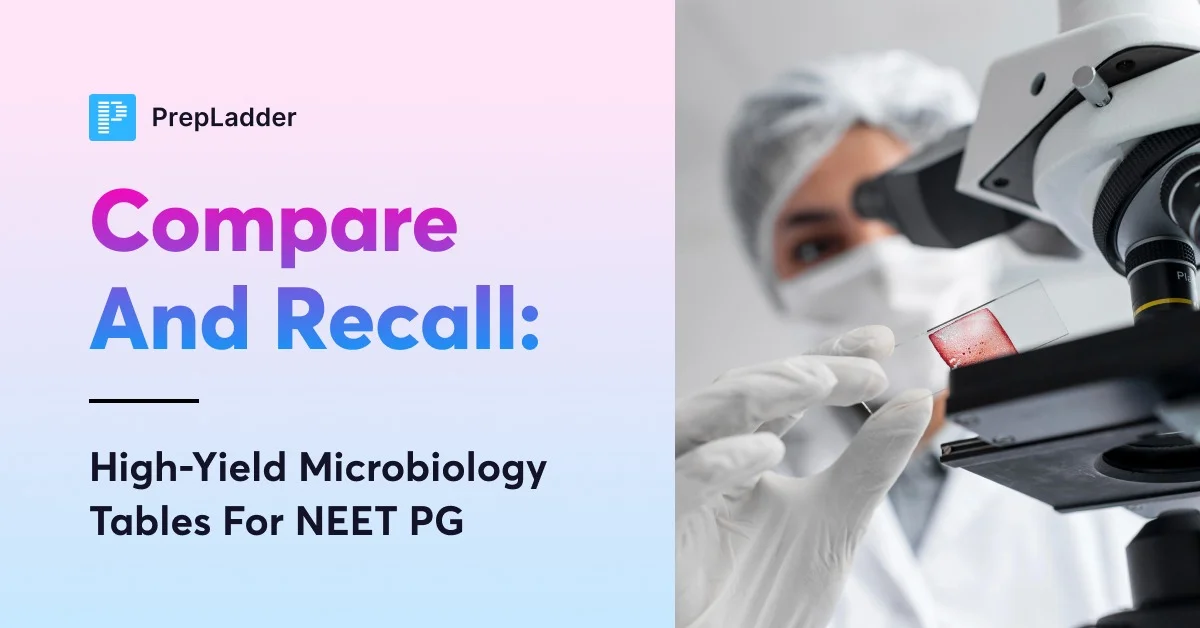Compare & Recall: High-Yield Microbiology Tables for NEET PG
Jul 18, 2025
Navigate Quickly
Table 1
Scientist
Table 2
Differences between Electron light Microscope
Table 3
Endotoxins vs Exotoxins
Table 4
Difference between prokaryote and eukaryote
Table 5
Bacillus Cereus
Table 6
Differences between lepromatous and tuberculoid leprosy
Table 7
Table 8
Difference between HSV-1 and HSV-2
Table 9
WHO Grading Dengue Infections
Table 10
Naegleria Fowleri vs Acanthamoeba

Table 1
Scientist
Scientist Found/Known as Joseph Lister Father of antiseptic surgeryFirst used carbolic acid Anton Von Leeuwenhoek Father of the light microscope (Unilocular)
The first thing he visualised under his microscope was Animalcules.
The Jansen duo gave us the compound microscope.Ernst Ruska Father of electron microscope Edward Jenner First vaccine- smallpox
Prepared using cowpoxKarry B Mullis PCR Sanger Sanger sequencing H C Gram Gram staining Kleinberger L forms (cell wall deficient) Alexander Fleming Penicillin Barbara Mcclintock Transposons (Jumping genes)
Table 2
Differences between Electron light Microscope
Electron Microscope Features Light Microscope 2-2.5% Glutaraldehyde Fixation 10% Neutral Buffered Formalin Makes eye water. Embedded in resin Embedding Embedding in paraffin wax Copper metal slides Slide Glass slides Electron Source Transmitted light Vacuum Medium Air 0.5 nm Resolution 0.2 micron 
Table 3
Endotoxins vs Exotoxins
Endotoxin Exotoxin Present in lipid - AIn gram negative cell wall Made of proteins Gram negative bacteria In both GNB and GPC Heat stabile Heat labile Low antigenicity High antigenicity Cannot Toxoid production is possible
Can be used for vaccine production Needed in large amounts to create effects Small amounts can mediate effects Produces constant effect Variable effect Release on lysis of cell Released as secretions
Except botulinum toxin - released on lysis of cell
Table 4
Difference between prokaryote and eukaryote
Prokaryote Feature Eukaryote Called nucleoid
No proper nucleus Nucleus All present Single circular dsDNA Chromosome Multiple linear Plasmids Extra chromosomal DNA Mitochondrial DNA Absent Organelles Present NAM NAG Cell wall Absent Sterols absent Cell membrane Sterols + 70 S Ribosomes 80 S Present
Site of Respiration Mesosomes Absent
Table 5
Bacillus Cereus
Features Emetic type Diarrheal type IP <6 hours 8-16 hours Food Chinese fried rice Meat and milk Heat Heat Stable Heat labile MOA Increased CGMP Increase CAMP Toxins Cerulide → Vagomimetic action Nhe toxins → secretory Diarrhea
Table 6
Differences between lepromatous and tuberculoid leprosy
LL TT Bacillary load Multi bacillary. Pauci bacilliary. Bacteriological index Higher load.4-6+ 0-1+ Skin lesions Leonine facies.
Alopecia.Few. Nerve lesions Late. Early. Cell-mediated immunity Low. Normal. Lepromin test Negative. Positive. CD4/CD8 1:2 2:1 Humoral immunity Increased. Normal. Macrophages Negative. Present. Giant cells Negative. Present.
Table 7
Member Motility Lactose fermenting/ Non-lactosefermenting IMViC Urease E. coli Motile Lactose fermenting + + - - Negative Klebsiella Non-motile Lactose fermenting - - + + Positive Enterobacter Motile Lactose fermenting - - + + Negative Citrobacter Motile. Lactose fermenting V Negative Shigella Non-motile Non-lactose fermenting - + - - Negative Salmonella* Motile Non-lactose fermenting - + - + Negative Proteus Motile Non-lactose fermenting V Positive Yersinia Motile/Non-motile Non-lactose fermenting - + - - Negative
Table 8
Difference between HSV-1 and HSV-2
|
Difference between HSV-1 and HSV-2 |
||
|
Properties |
Herpes simplex virus – 1 |
Herpes simplex virus – 2 |
|
Transmission |
Direct contact with mucosa or abraded skin |
Sexual mode or vertical mode |
|
Latency |
Trigeminal ganglia |
Sacral ganglia |
|
Age affected |
Young children |
Young adults |
|
Antibody distribution in adults |
Present in 70%-90% of people |
Present in 20% of people |
|
Common manifestations |
|
|
|
Egg (CAM*) |
Forms smaller pocks |
Forms larger pocks |
|
Chick embryo fibroblast |
Does not grow well |
Replicates well |
|
Neurovirulence |
Less |
More |
|
Drug resistance |
Less |
More |
|
Antigenic homology |
HSV 1 and 2 show > 80% antigenic homology |
|
|
Genomic sequence homology |
HSV 1 and 2 show > 50% homology in the genomic sequence |
|
Table 9
WHO Grading Dengue Infections
|
DF/DHF |
Grade |
Symptoms |
Labs |
|
DF |
- |
|
|
|
DHF |
I |
|
|
|
DHF |
II |
|
|
|
DHF |
III |
|
|
|
DSS |
IV |
|
|
Table 10
Naegleria Fowleri vs Acanthamoeba
|
Features |
Naegleria Fowleri |
Acanthamoeba |
|
Disease |
PAME |
GAME |
|
Risk factor |
Swimming |
Immunodeficiency |
|
Infective form |
Trophozoite |
Both Cyst and Trophozoite |
|
Clinical course |
Acute (fatal <5 days) |
Chronic (late) |
|
Spread |
Neural |
Blood |
|
Diagnosis |
CSF
|
Brain biopsy
|
|
Culture |
NNA (Non-Nutrient Agar) - lawn culture of Entamoeba coli |
NNA (Non-Nutrient Agar) -lawn culture of Entamoeba coli |
|
Gold standard |
NAAT (Nucleic Acid Amplification Testing) |
NAAT (Nucleic Acid Amplification Testing) |
|
Treatment |
Amphotericin B |
Pentamidine + Azole + Sulfonamide + Flucytosine |
Download the PrepLadder app now and unlock a 24-hour FREE trial of premium high-yield content. Access Smarter Video Lectures also in हिंglish, Game Changing Qbank, Audio QBank, Structured Notes, Treasures, Mock test for FREE to ace your NEET PG preparation. Elevate your study experience and gear up for success. Start your journey with PrepLadder today!

PrepLadder
Access all the necessary resources you need to succeed in your competitive exam preparation. Stay informed with the latest news and updates on the upcoming exam, enhance your exam preparation, and transform your dreams into a reality!
Top searching words
The most popular search terms used by aspirants
- NEET PG Micrbiology Preperation
PrepLadder Version X for NEET PG
Avail 24-Hr Free Trial
